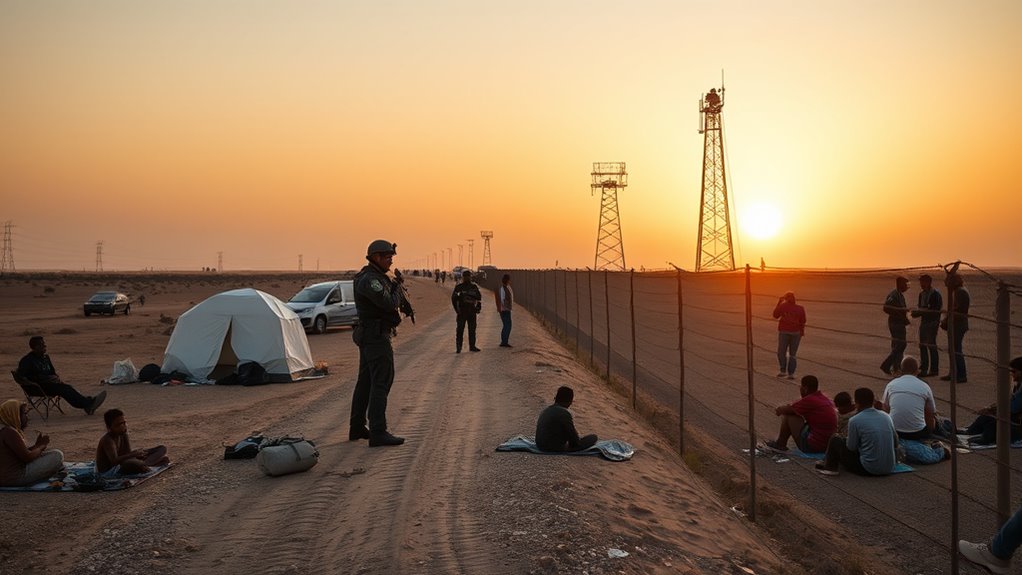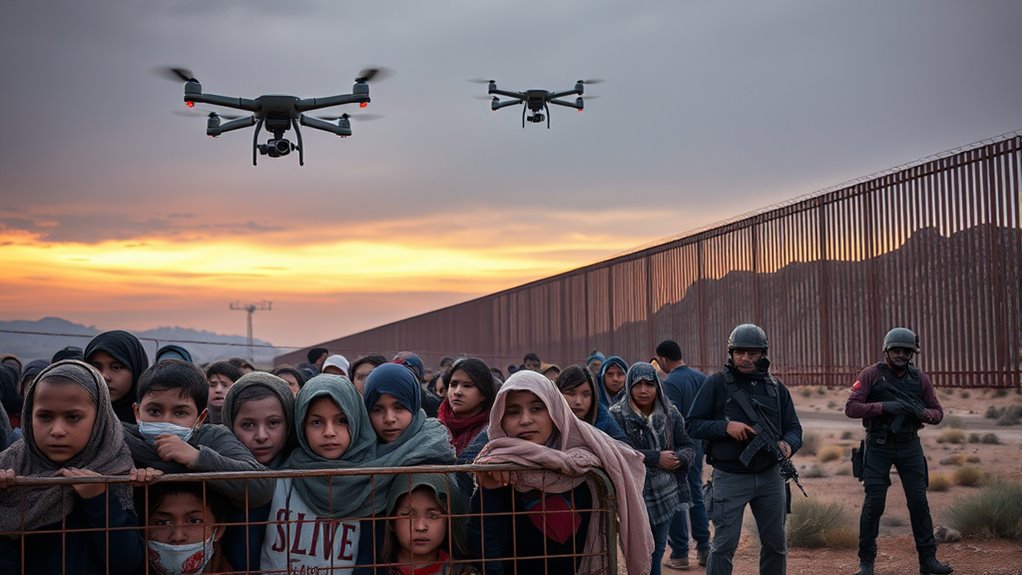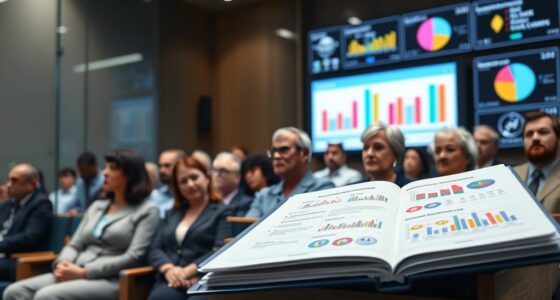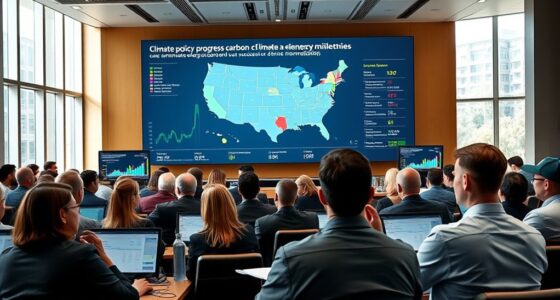In 2025, U.S. border policies focus on boosting security with advanced technology, more patrol staffing, and stricter entry rules. While these measures aim to curb illegal crossings, they also highlight efforts to protect migrant rights through fair treatment, legal access, and humane processing. Balancing security with dignity remains a priority, though challenges persist. To understand how these updates impact migration and enforcement, explore the latest strategies shaping border security today.
Key Takeaways
- 2025 policies focus on advanced surveillance, increased staffing, and stricter entry requirements to deter illegal crossings.
- Enforcement emphasizes rapid deportations and penalties while attempting to uphold humane treatment and legal rights.
- New measures aim to balance border security with migrants’ access to legal pathways and protection from exploitation.
- Technological innovations and community programs are integrated to manage migration humanely and efficiently.
- Ongoing challenges include maintaining dignity, transparency, and fair procedures amid tightening border controls.

Immigration at the U.S. border remains a complex and often contentious issue, as thousands of people attempt to enter the country each day seeking safety, opportunity, or better economic prospects. This ongoing movement highlights the delicate balance between maintaining border security and respecting migrant rights. As a concerned observer or policymaker, you understand that effective border security measures are vital to prevent illegal crossings, human trafficking, and drug smuggling. But these measures shouldn’t come at the expense of the rights and dignity of migrants. Striking that balance is a persistent challenge, especially with the evolving policies in 2025 that aim to tighten border controls while ensuring fair treatment.
In recent months, new policies have emphasized advanced surveillance technology, increased border patrol staffing, and stricter entry requirements. These efforts are designed to secure borders and reduce illegal crossings, but they also raise questions about how migrants are treated during the process. You recognize that border security isn’t just about physical barriers; it involves an extensive approach that includes intelligence sharing, community engagement, and humanitarian considerations. Ensuring migrants’ rights means providing access to legal pathways, proper documentation, and protection from exploitation. You see that policies must prioritize humane treatment, regardless of whether someone is seeking asylum or trying to enter for work. Incorporating multi-faceted security measures can enhance the effectiveness of border enforcement while respecting human dignity.
Border security requires humane treatment, legal access, and humanitarian considerations alongside technological and enforcement efforts.
At the same time, the government has doubled down on efforts to deter illegal crossings through penalties and rapid deportations. While these measures aim to uphold national sovereignty, they can also lead to concerns about due process and the potential for family separations. You understand that migrant rights include the right to legal representation, fair hearing procedures, and protection against refoulement—returning someone to a country where they face danger. Balancing these rights with border security requires transparency and accountability, ensuring that enforcement doesn’t infringe on basic human rights.
As 2025 policies unfold, you see a push toward more integrated approaches—combining technological innovations with community-based programs that support migrants’ well-being. This includes access to legal aid, health services, and safe processing centers. You recognize that effective border security isn’t just about stopping people; it’s about managing migration humanely and efficiently. Respecting migrant rights while safeguarding borders is a complex task, but it’s essential for a fair and just immigration system. Moving forward, you believe that policies should focus on smart security measures that uphold both safety and human dignity.
Frequently Asked Questions
How Will the New Policies Affect Asylum Seekers’ Processing Times?
You’ll find that new policies aim to speed up asylum processing by increasing border technology and reducing the asylum backlog. With improved tech, authorities can review cases more efficiently, cutting wait times. However, some believe these changes might also lead to stricter criteria, which could impact processing times unpredictably. Overall, expect a mix of faster decisions for some and increased scrutiny for others, depending on how the policies are implemented.
What Are the Economic Impacts of Increased Border Enforcement?
You might notice that increased border enforcement subtly shifts the border economy, affecting local businesses and communities. It can tighten the labor market, making it harder for industries relying on migrant workers to find staff, which may lead to higher costs and reduced competitiveness. While some sectors benefit from stricter policies, overall, these changes can slow economic growth and create uncertainty in the broader labor market.
Will There Be Changes to Visa Eligibility Criteria Under the New Update?
Yes, there will be changes to visa eligibility criteria under the new policy updates. You may find that some visa categories become more restrictive, requiring stricter qualifications or additional documentation. These policy changes aim to prioritize certain applicants and enhance border security. If you’re applying for a visa, it is crucial to review the updated eligibility rules carefully to guarantee you meet the new requirements and avoid potential delays or denials.
How Does the Policy Address Humanitarian Concerns at the Border?
You’ll see the policy prioritizes humanitarian concerns by improving detention conditions, ensuring humane treatment, and enhancing refugee protection. It emphasizes swift, fair processing for those seeking asylum, reducing overcrowding and providing access to legal aid. The goal is to balance border security with compassion, so you can expect measures that uphold dignity and uphold the rights of vulnerable individuals while maintaining effective border management.
What Are the Long-Term Demographic Effects of the 2025 Immigration Reforms?
You’ll notice demographic shifts and population growth as a result of the 2025 immigration reforms. These policies may lead to a more diverse population, with increased representation from various regions. Over the long term, this could strengthen the labor force and boost economic growth. However, it might also strain resources and infrastructure if growth isn’t managed well. Overall, expect significant changes in community compositions and societal dynamics in the coming decades.
Conclusion
As you witness the ongoing changes at the U.S. border, remember that behind every policy and statistic are lives seeking hope and safety. These decisions shape not just borders, but the very soul of a nation built on dreams. Will we choose compassion over fear? The future depends on your voice and actions. Stand for humanity, for in doing so, you hold the power to turn despair into hope—because every person deserves a chance.










